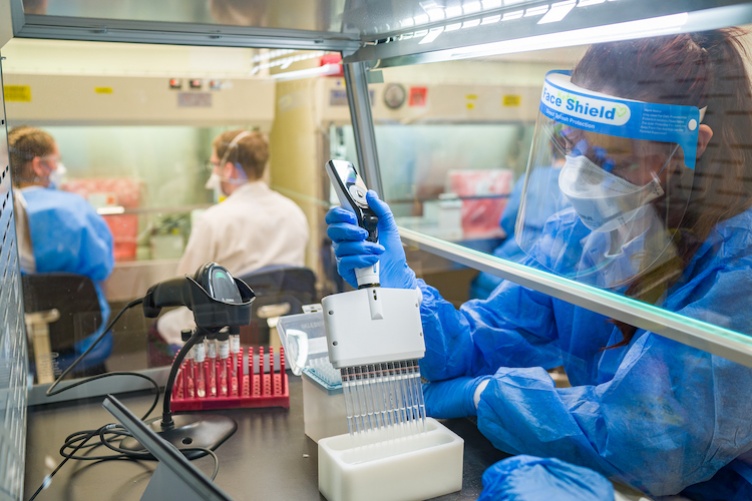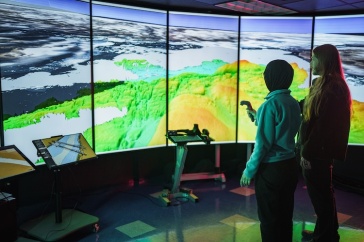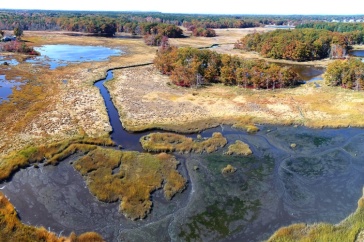
The UNH COVID-19 lab is now testing specimens from long-term care facilities and K-12 outlets in New Hampshire.
Elise Sullivan had her doubts.
As she watched from her vantage point testing for COVID-19 for the New Hampshire Public Health Laboratory while UNH scrambled to finish assembling its own COVID-19 testing lab just days before the start of the fall semester last year – installing equipment at the eleventh hour and preparing for an operation that had never been undertaken – she wasn’t certain it was going to last.
“At the time, I thought there’s no way UNH is going to get this to work, it’s just way too over ambitious,” Sullivan says.
Now, more than a full calendar year later, Sullivan is still catching her breath from guiding the lab through the busiest day in its brief history Sept. 9, a day that saw technicians and student workers process more than 6,000 specimens in less than 24 hours.
What’s more, those specimens now come from more than 40 long-term care facilities in New Hampshire and an increasing number of K-12 schools in the state on any given day, as the lab has gone from testing only UNH students at the outset to becoming one of the most powerful tools the Granite State has in the battle against COVID-19.
So, it’s safe to say those early doubts have all been alleviated.
“From my perspective, it’s kind of miraculous what’s been done,” Sullivan, who had previously spent 15 years on the faculty at UNH, says. “Once I had the opportunity to come back to UNH and I met everyone and saw the operation, I realized it was just a great combination of the right people and the right minds and the right attitudes that all came together. It’s like startup companies – most don’t work, but once in a while you have just the right brilliant combination.”
That brilliant combination was enough to lure Sullivan back to UNH to help lead the day-to-day activities as the lab manager. She returned for the spring semester last year and began taking over daily leadership duties from Kelley Thomas, director of the Hubbard Center for Genome Studies, who was instrumental in starting the lab and remains the scientific director of the facility.
There have been seemingly countless changes since the lab first opened its doors, not the least of which are the doors itself – the lab has taken up residence in Gregg Hall after moving from its initial location. The new space, which is much larger overall and made it possible to expand from two PCR machines on-hand to five, has allowed for the significantly increased efficiency and output that made a 6,000-specimen day a reality.
Perhaps the most significant development isn’t the number of specimens itself but rather where those specimens come from. When the lab first opened at the outset of the pandemic, the focus was simply on keeping the UNH campus open by testing students twice per week to maintain timely data. Faculty and staff weren’t even tested in the lab at the start, instead heading to Convenient MD as part of a partnership with the university.
The on-campus lab began accepting faculty and staff specimens during the middle of the fall semester last year and later began to accept those from long-term care facilities. As recently as last spring, the lab was testing for four such facilities – that number has since grown to 45.
And this fall the lab has begun to partner with some K-12 schools in New Hampshire, including neighboring Oyster River. Between the long-term care facilities and local schools, the lab is now processing samples from an incredibly wide range of ages, including the most vulnerable populations on either end of that spectrum in New Hampshire.
“Of all the changes we’ve made, in my opinion that’s the most significant of them, that UNH is now supporting our state,” Sullivan says. “We are positioned in a way to be really helpful to a much larger group than we were last year.”
Another group that has benefited from the lab are the UNH students who have had the opportunity to work there, gaining hands-on experience during an unprecedented global health crisis. Both Sullivan and Thomas believe that will set them up for professional success.
“That’s really impactful,” Thomas says. “You’re talking about a large number of people with special experience – this is a really high-pressure health care environment.”
It’s also an environment that many people have had an important hand in building. Computational scientist Anthony Westbrook created the software that scans the barcode on each test and tracks it through the process – an invaluable contribution, Sullivan says – and the UNH police department has collected samples dropped off after hours and kept them refrigerated until they can be processed. Similar contributions around campus abound.
Perhaps the most critical partnership has been between the lab and the contact tracers at UNH Health and Wellness. The two entities are in constant contact to try to head off any potential outbreaks before they grow.
“They are the reason this works,” Thomas says of the contact tracers,” because we can test and come up with positives and negatives, but their ability to take that and turn it into action in a very short period of time is incredible.”
Indeed, the lab has entered the current semester as something of a well-oiled machine, with a year of experience and the perspective of hindsight to draw on. But there’s perhaps no better illustration of the strangeness of the situation than the fact that despite helping to build such a successful infrastructure in a remarkably short time, Thomas and his partners can’t wait until it isn’t nearly as necessary.
“I hope we’re out of business at some point soon,” Thomas quips. “But we are going to be here as long as we’re needed. Not just the lab, but also the university, has matured so much through all of this, and to expand and serve the state the way we are is really fantastic.”
-
Written By:
Keith Testa | UNH Marketing | keith.testa@unh.edu

















































